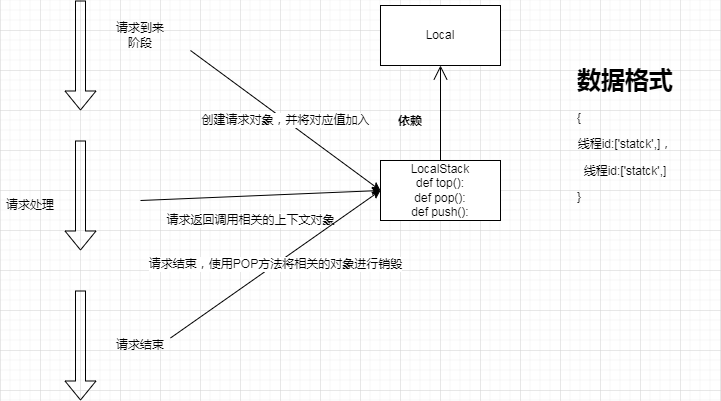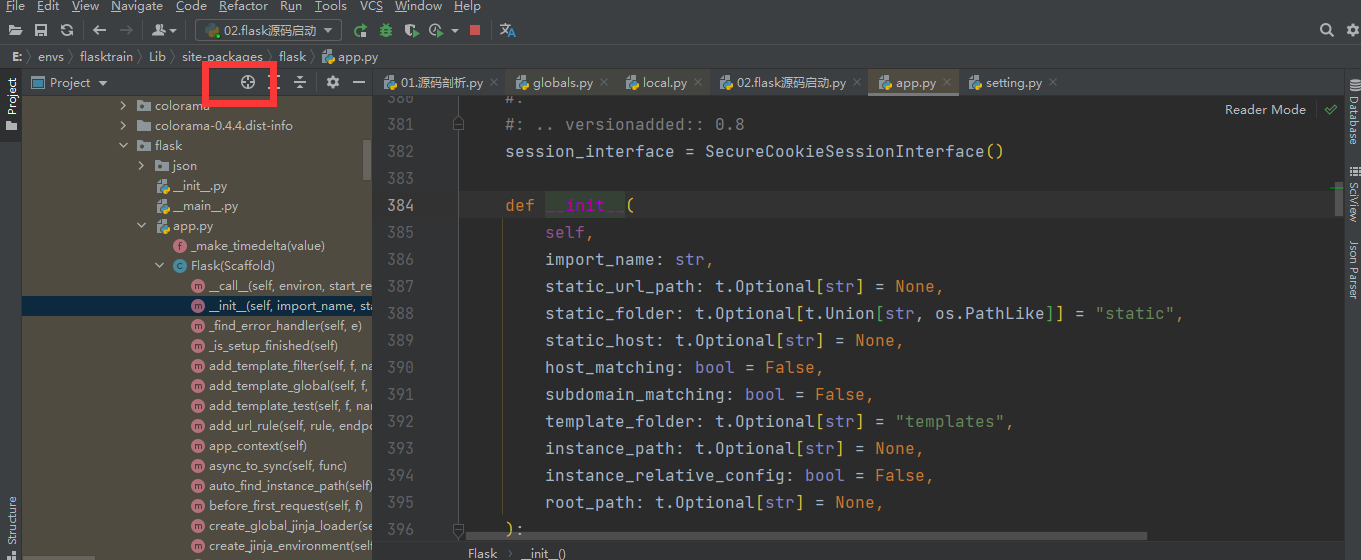flask 源码梗概
flask 中的线程主要基于LocalStack进行使用,在global中维护这个类的两个对象。
# context locals
_request_ctx_stack = LocalStack() # 请求上下文:主要有 request 和 session 两个对象
_app_ctx_stack = LocalStack() # 应用上下文 :主要有 app 和 g 两个值。

额外补充:点击下图框选的图标,可以直接定位到源码所在的文件以及相关的文件路径。

flask 源码启动阶段
说明:启动阶段即为,flask 初始化创建网站开始,请求还未到来之时的阶段。
启动阶段的代码主要如下所示:
from flask import Flask
app = Flask(__name__) # 创建app 对象
app.config.from_object("config.settings") # 加载配置文件
@app.route("/index") # 注册视图函数
def index():
return "Hello World"
if __name__ == '__main__':
app.run() #程序启动
程序启动的步骤主要是有werkzug部分执行app的__call__()方法,上述步骤在前面已经剖析过此处不在进行剖析。
-
实例化对象
app = Flask(__name__) # 创建app 对象该步骤会去执行
Flask的初始化函数__init__()方法。该方法的剖析如下class Flask(Scaffold):# 继承与内部实现的类 config_class = Config secret_key = ConfigAttribute("SECRET_KEY") url_map_class = Map ''' 存储了rule 对象 ''' url_rule_class = Rule ''' 存储了 路由,以及相关的请求方式, '/index',['GET','Post',],endpoint ''' config_class = Config# 此处与配置文件有关 default_config = ImmutableDict( # ImmutableDict是实现一个不可变的字典 { "ENV": None, "DEBUG": None, "SECRET_KEY": None, "SESSION_COOKIE_NAME": "session", "PREFERRED_URL_SCHEME": "http", "JSONIFY_PRETTYPRINT_REGULAR": False, "JSONIFY_MIMETYPE": "application/json", # 更多的默认配置... } ) '''... 更多其他的静态变量,不在展示''' def __init__( self, import_name: str, static_url_path: t.Optional[str] = None, static_folder: t.Optional[t.Union[str, os.PathLike]] = "static", static_host: t.Optional[str] = None, host_matching: bool = False, subdomain_matching: bool = False, template_folder: t.Optional[str] = "templates", instance_path: t.Optional[str] = None, instance_relative_config: bool = False, root_path: t.Optional[str] = None, ): # 实例属性 self.instance_path = instance_path self.url_map = self.url_map_class() # 加(),此处实例化了一个 Map()对象,静态属性url_map_class = Map self.config = self.make_config(instance_relative_config) self.view_functions: t.Dict[str, t.Callable] = {} # view_functions 为一个字典 # ... 更多的实例化属性以及注释,此处不在展示。 if self.has_static_folder: assert ( bool(static_host) == host_matching ), "Invalid static_host/host_matching combination" # Use a weakref to avoid creating a reference cycle between the app # and the view function (see #3761). self_ref = weakref.ref(self) self.add_url_rule( # 此阶段的语句表示,即便是没有注册过任何视图函数以及路由,也会有相关的静态路由直接存储在对象中。 f"{self.static_url_path}/<path:filename>", endpoint="static", host=static_host, view_func=lambda **kw: self_ref().send_static_file(**kw), ) -
加载配置文件
app.config.from_object("config.settings") # 加载配置文件 ''' 此步骤便于理解可以写为以下两步 v = app.config v.from_object("config.settings") '''from_object()源码如下图def from_object(self, obj: t.Union[object, str]) -> None: if isinstance(obj, str): # 判断参数类型 obj = import_string(obj) for key in dir(obj): # 循环对象中的所有键值对 if key.isupper():# 检查对否都为大写字母 self[key] = getattr(obj, key) # 通过反射的方式为(self)当前对象进行赋值当前
self是谁的对象需要继续看是谁在调用它。# app.config 是因为实例属性中包含了相关的变量 self.config = self.make_config(instance_relative_config) # 执行的是make_config方法make_config 的源码如下:
def make_config(self, instance_relative: bool = False) -> Config: #此处表明返回的是一个Config对象 root_path = self.root_path if instance_relative: root_path = self.instance_path defaults = dict(self.default_config) #默认配置,导入的是Flask内部的默认配置 defaults["ENV"] = get_env() defaults["DEBUG"] = get_debug_flag() return self.config_class(root_path, defaults)由上述源码可知,当我们不去加载自己的配置文件的时候,Flask 会默认加载相关的配置。
此处的返回值为
config_class(),在flask源码中,静态变量有config_class = Config,表明该方法是该类的一个赋值,但是并未实例化,此处加上(),表示实例化该对象,相关的源码如下所示:class Config(dict): # 执行初始胡方法 def __init__(self, root_path: str, defaults: t.Optional[dict] = None) -> None: super().__init__(defaults or {}) # 执行父类的传参,默认配置,或者是一个空字典 self.root_path = root_path # 将路径设置到相关的属性上由于该类继承的是空字典或者是
flask内部的不可变字典ImmutableDict,所以回到本质上讲,配置文件的加载是将相关的配置,以键值的形式加载到对应的字典中,配置文件的对象是一个字典。 -
注册路由及视图函数
# @app.route("/index",methods=['GET','POST']) @app.route("/index") # 注册视图函数 def index(): return "Hello World"上述可知
Flask类继承与Scaffold类,而装饰器route则属于该父类多定义的方法class Scaffold: # 该方法符合装饰器的定义 def route(self, rule: str, **options: t.Any) -> t.Callable[[F], F]: def decorator(f: F) -> F: # 定义函数 endpoint = options.pop("endpoint", None) # 检查参数中是否存在路由的反向解释符。 self.add_url_rule(rule, endpoint, f, **options) # 执行相关的路由添加函数。 # !!! 特别注意此处执行的`add_url_rule`并不一定是父类中的该方法,flask中重写了该方法,此时的self,代指的是当前的 app 对象 return f return decorator # 返回内部所执行的函数。add_url_rule相关源码如下补充:字典的
pop()方法。pop() 方法从字典中删除指定的项目。被删除的项目的值是这个 pop() 方法的返回值,第二个参数可以设置默认返回值。请看下面的例子。
dic = {1:"aa","methods":['GET','POST']} print(dic.pop("methods",None)) # ['GET', 'POST'] print(dic) # {1: 'aa'} print(dic.pop("methodsasss",None)) # Noneflask 源码中的请求方法的限定正式基于此方法实现获取传入的值。
@setupmethod def add_url_rule( self, rule: str,# 路由字符串 endpoint: t.Optional[str] = None,# '路由的名字' view_func: t.Optional[t.Callable] = None,# 视图函数 provide_automatic_options: t.Optional[bool] = None, **options: t.Any, ) -> None: if endpoint is None: endpoint = _endpoint_from_view_func(view_func) # endpoint 如果为空,则能与函数的名 options["endpoint"] = endpoint # 将 endpoint 值写入到字典中去, # 通过此方法获取相应的 methods的列表值,没有传入则返回值为None methods = options.pop("methods", None) # 此处因为route装饰器可以传入参数 methods=['GET','POST'] # if the methods are not given and the view_func object knows its # methods we can use that instead. If neither exists, we go with # a tuple of only ``GET`` as default. if methods is None: # 使用反射,为view_func 设置相关的值,没有传入方法的时候,或者将methods使用GET 作为默认年至进行赋值给 methods = getattr(view_func, "methods", None) or ("GET",) # view_func 为装饰器传入的函数,使用 getattr 获取相关的值 if isinstance(methods, str): # 检查为字符串类型 raise TypeError( "Allowed methods must be a list of strings, for" ' example: @app.route(..., methods=["POST"])' ) methods = {item.upper() for item in methods} # 使用集合去重,并全部转换为大写字母。 # Methods that should always be added required_methods = set(getattr(view_func, "required_methods", ()))# 获取被允许的的方法设置为集合,不存在则设置为空集合 # starting with Flask 0.8 the view_func object can disable and # force-enable the automatic options handling. if provide_automatic_options is None: # 从试图函数中获取相关的值,不存在则赋值为空, provide_automatic_options = getattr( view_func, "provide_automatic_options", None ) # 是否禁用http,OPTIONS 自动响应的实现。 if provide_automatic_options is None: if "OPTIONS" not in methods: provide_automatic_options = True required_methods.add("OPTIONS") else: provide_automatic_options = False # Add the required methods now. methods |= required_methods # 更新集合,添加所有其他元素,Python2.6 版本更新的语法。 # url_rule_class这个变量在Flask的类属性中进行了声明, url_rule_class = Rule rule = self.url_rule_class(rule, methods=methods,**options) # 将路由规则和请求方式传入,返回的是Rule对象 # 此时rule对象中存储了路由和请求方式,如果存在endpoint,options中也一并写入了endpoint。Rule的参数会接收这些参数 # 将自动响应的方式,赋值到rule对象中去。 rule.provide_automatic_options = provide_automatic_options # type: ignore self.url_map.add(rule) # 将rule对象添加到对应的map对象中, if view_func is not None: # 如果视图函数不为空 old_func = self.view_functions.get(endpoint) # 字典中根据endpoint 获取相关的函数 if old_func is not None and old_func != view_func: # endponit 重复,抛出相关的异常 raise AssertionError( "View function mapping is overwriting an existing" f" endpoint function: {endpoint}" ) self.view_functions[endpoint] = view_func # 将试图函数写入对应的字典中,使用endpoint作为字典的键相关联的源码
def _endpoint_from_view_func(view_func: t.Callable) -> str: assert view_func is not None, "expected view func if endpoint is not provided." return view_func.__name__ # 返回函数的名称。总结:
1.将url='/index' 和 methods= ['GET','Post'] 和 endpoint ='index'封装到Rule对象,注:endpoint 默认是函数名 2.将Rule 对象添加到 url_map 中去 3.把 endpoint 和函数的对应关系放到了 view_functions 字典中去。 -
目前总结
# 源码中使用的主要属性为一下步骤。 app.config app.url_map app.view_functions -
运行
app.run(),本步骤与上述的启动函数相同。